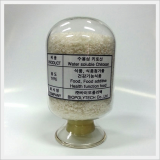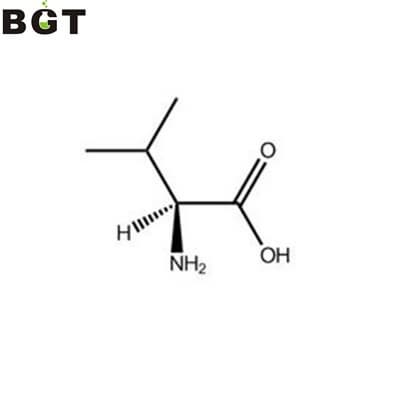L-Valine, CAS 72-18-4
Negotiable Min Order Quantity Unit
- Required Quantity
-
- Place of Origin
- China
- Brand name
- BGT
- Payment Terms
- L/C,Others,T/T
- Production method
- Negotiable
- Shipping / Lead Time
- Negotiable / Negotiable
- Category
- Organic Intermediate , Pharmaceutical Intermediates
Banff Green Technologies, Inc.
- Verified Certificate
-
8

| Product name | L-Valine, CAS 72-18-4 | Certification | - |
|---|---|---|---|
| Category |
Organic Intermediate
Pharmaceutical Intermediates |
Ingredients | - |
| Keyword | l-valine , 72-18-4 | Unit Size | - |
| Brand name | BGT | Unit Weigh | - |
| origin | China | Stock | - |
| Supply type | - | HS code | - |
Product Information
What is L-Valine?
L-Valine is one of the essential amino acids. It exists in the leaves and smoke of flue-cured tobacco and burley tobacco. It is one of the branched chain amino acids (BCAA).
The important character of L-Valine
L-type amino acids are easier to absorb than D-type amino acids. There is competition among the organism’s transportations of amino acids. The transportation of one amino acid could be restrained by the existence of another amino acids. For example, excess lysine in the formula feed will restrain the absorption of arginine. However, L-Valine of high concentration (100mM) does not affect the absorption of L- methionine. This is because L-Valine could be transported by another channel.
What does L-Valine do?
In recent years, people found out that L-Valine is an important intermediate for synthesizing various APIs and Agricultural chemicals. L-Valine’s annual consumption surges to thousands of tons ever since.
For human-beings
L-Valine can cure hepatic failure and central nervous system dysfunction. The requisite amount for male adults is 10mg/(kg·d). The physiological effect of L-Valine is twice as that of D-valine. Lack of L-Valine can cause neurological disorder, arrest of development, weight loss, anemia, etc.
As a nutritional supplement, L-Valine can be used for formulating amino acids infusion and synthesis of amino acid preparation with other essential amino acids. In particular, it could be used to formulate high branched chain amino acid infusion (i.e. 3H infusion) and oral liquid (i.e. Liver Ann dry syrup).
Moreover, if apply valine (1g/kg) to rice-made pastry, there will be an aroma of sesame. Thus, L-Valine could be applied to bread for taste improvement.
For animals
L-Valine can increase the milk yield of nursing sows. This is because valines can affect the synthesis of alanine and help to relax the muscles. The increased alanine helps sows to accommodate the need of breast tissues for glucose raw materials, and therefore increase the milk yield.
L-Valine can improve animals’ immune functions. Valines can promote the bone cells to converse to mature T cells. By contrast, lack of valines can decrease the complement C3 and the iron binding globulin, and significantly hinder the growth of thymus and peripheral lymphoid tissue. When weaning piglets lack valines, their ability to synthesize specific antibody will decline. When chicken lacks valines, their immunization against avian pneumo-encephalitis virus will decline.
L-Valine affects animals’ endocrine level. Based on research, adding valines to the food of nursing sows and rats will increase the concentrations of prolactin and growth hormone in their blood.
Ways to synthetize L-Valine
1. By the condensation and reduction of 2-amino thiazole and nitrobenzene sulfonyl chloride.
2. Using isobutyl aldehyde as raw material, there are many ways to synthesize raceme valine. For example, isobutyl aldehyde and ammonia generate aminoisobutanol, and then react with hydrogen cyanide to generate amino azodi isobutyronitrile. After that, valines is generated through hydrolysis. There are also many ways to resolve racemate. For example, hydrolyzing the enzyme of Acyl -DL- amino acid, and then take advantage of the solubilities difference between the free amino acids and acylation to separate it.
3. Fermentation: For mass-production of L-Valine, microbe fermentation is adopted. Japan is of world advanced level at this. The fermentation is processed in sterile containers. In the process of fermentation, the temperature, aeration, stirring, and PH value are all controllable, and bean oil is added as carbon source and anti-foam agent. The purity of the culture medium of fermentation is determined by checking the growth and evenness of the bacterial colony. When fermentation has been processed to the expected level, remove the zymotic fluid for extraction. After that, acidize the zymotic fluid, and then filter it with solvent. Under the acidic PH value, the product will be obtained through crystallization. Screen and mix the crystal well, and then separate it, dry and wrap it up. Valine produced through fermentation are all L-type. There is no need of optical resolution.
Conclusion
The current trend of synthesizing agricultural chemicals is to develop green agricultural chemicals, whose main characters are: 1)super efficient, small dosage and quick results; 2)high selectivity, only working for specific pests; 3)pollution free, low or no toxin, and the ability of fast degradation.
In nature, organisms produce tens of thousands of natural products basing on the substance metabolism of amino acids, carbohydrate and lipd through green production process that is incomparable by chemical plants. If the chemical structures of agricultural chemicals are in accordance with the substance structures in nature, due to the existence of the microbe that could decompose them, the agricultural chemicals will be easy to resolve, leaving few residue and pollution.
Amino acids are common chemical compound in nature. They have two active functional groups that could take part in most reactions of carboxylic acid and primary amine, as well as synthesize heterocyclic groups such as oxazole ring, pyrrol ring, imidazole ring, and benzothiazole ring. Furthermore, most α-amino acids, except glycine, have chiral carbon atom, therefore, using α-amino acids as agricultural chemicals synthesis units, the raw materials are actually chiral synthesis units. Chiral agricultural chemicals will be obtained through a series of stereo-chemical control of treactions. The chiral agricultural chemicals are completely in accordance with the standards of green agricultural chemicals. They contain one or more highly effective isomers, their necessary dosage is small, they are compatible with the environment, effective and lowly toxic, with good selectivity and low residue. Moreover, the decomposed amino acids can be used as a growth and nutrition agent for plants, working to improve the production of crops.
In the past, the production of amino acids is low and the price is high in China. This restrains the application of amino acids in agricultural chemicals research. Currently, the industrialization of amino acids in China has reached over 80%. With the consistent improvement of the production and fermentation of amino acids, the amino acids’ advantages of extensive sources, easy access of raw materials, simple structure, and easiness of decomposition are more and more prominent. This will promote the application and development of amino acids in the synthesis of agricultural chemicals in China.
- Product Info Attached File
B2B Trade
| Price (FOB) | Negotiable | transportation | - |
|---|---|---|---|
| MOQ | Negotiable | Leadtime | Negotiable |
| Payment Options | L/C,Others,T/T | Shipping time | Negotiable |
- President
- Xue Yang
- Address
- Floor 29, CapitaMalls Plaza, No. 6088 Humin Rd., Minhang Dist.
- Product Category
- Antibiotic and Antimicrobial Agents,Inorganic Salts,Organic Intermediate,Pharmaceutical Intermediates
- Year Established
- 2014
- No. of Total Employees
- 101-500
- Company introduction
-
Banff Green Technologies, Inc. is a technologically innovative company that focuses on chemicals, materials, pharmaceuticals, crop science and environmental technology. The company headquarter is based in Shanghai, China. Our research and development team is comprised of a talented and experienced team of PhD’s with strong scientific backgrounds dedicated to our mission. We are also supported by strong infrastructure, which include state of the art lab facilities, two pilot facilities and seven manufacturing sites located in five provinces in China.Our core businesses span over the following areas: R & D, production and sales of fine and specialty chemicals, contract manufacturing services and custom synthesis.Our main products are: fluorinated fine chemicals (mainly Diethyl fluoromalonate and dimethyl fluoromalonate), D-p-Methyl Sulfone Phenyl Ethyl Serinate, Florfenicol, D-(-)-threo-2-Amino-1-(4-nitrophenyl)-1,3-propanediol, and chloramphenicol).Our corporate mission is to achieve environmental protection and sustainability while being socially responsible through our research and innovation. We sincerely hope to better serve our customers through every facets of their needs and together we can achieve a more sustainable future.
- Main Product
Related Products
beta-cyclodextrin

Water Soluble Chitosan
Betamethasone 17-valerate

3-amino-2-methylamino-5-(trifluoromethyl)pyridine
Drug, medicine, API, pharmaceutical raw material, surgical dressing



































 China
China



